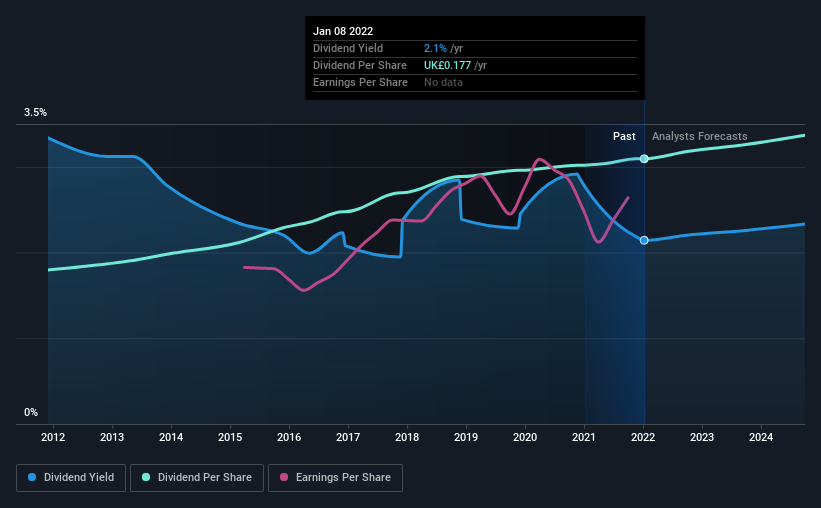Three Days Left Until The Sage Group plc (LON:SGE) Trades Ex-Dividend
Some investors rely on dividends for growing their wealth, and if you're one of those dividend sleuths, you might be intrigued to know that The Sage Group plc (LON:SGE) is about to go ex-dividend in just 3 days. Typically, the ex-dividend date is one business day before the record date which is the date on which a company determines the shareholders eligible to receive a dividend. It is important to be aware of the ex-dividend date because any trade on the stock needs to have been settled on or before the record date. Therefore, if you purchase Sage Group's shares on or after the 13th of January, you won't be eligible to receive the dividend, when it is paid on the 10th of February.
The company's next dividend payment will be UK£0.12 per share, and in the last 12 months, the company paid a total of UK£0.18 per share. Calculating the last year's worth of payments shows that Sage Group has a trailing yield of 2.1% on the current share price of £8.248. If you buy this business for its dividend, you should have an idea of whether Sage Group's dividend is reliable and sustainable. That's why we should always check whether the dividend payments appear sustainable, and if the company is growing.
See our latest analysis for Sage Group
If a company pays out more in dividends than it earned, then the dividend might become unsustainable - hardly an ideal situation. Sage Group is paying out an acceptable 67% of its profit, a common payout level among most companies. A useful secondary check can be to evaluate whether Sage Group generated enough free cash flow to afford its dividend. It paid out more than half (59%) of its free cash flow in the past year, which is within an average range for most companies.
It's encouraging to see that the dividend is covered by both profit and cash flow. This generally suggests the dividend is sustainable, as long as earnings don't drop precipitously.
Click here to see the company's payout ratio, plus analyst estimates of its future dividends.
Have Earnings And Dividends Been Growing?
Companies with consistently growing earnings per share generally make the best dividend stocks, as they usually find it easier to grow dividends per share. If earnings fall far enough, the company could be forced to cut its dividend. With that in mind, we're encouraged by the steady growth at Sage Group, with earnings per share up 9.9% on average over the last five years. While earnings have been growing at a credible rate, the company is paying out a majority of its earnings to shareholders. Therefore it's unlikely that the company will be able to reinvest heavily in its business, which could presage slower growth in the future.
Another key way to measure a company's dividend prospects is by measuring its historical rate of dividend growth. Since the start of our data, 10 years ago, Sage Group has lifted its dividend by approximately 5.6% a year on average. We're glad to see dividends rising alongside earnings over a number of years, which may be a sign the company intends to share the growth with shareholders.
To Sum It Up
Is Sage Group worth buying for its dividend? Earnings per share growth has been unremarkable, and while the company is paying out a majority of its earnings and cash flow in the form of dividends, the dividend payments don't appear excessive. While it does have some good things going for it, we're a bit ambivalent and it would take more to convince us of Sage Group's dividend merits.
Wondering what the future holds for Sage Group? See what the 21 analysts we track are forecasting, with this visualisation of its historical and future estimated earnings and cash flow
We wouldn't recommend just buying the first dividend stock you see, though. Here's a list of interesting dividend stocks with a greater than 2% yield and an upcoming dividend.
Have feedback on this article? Concerned about the content? Get in touch with us directly. Alternatively, email editorial-team (at) simplywallst.com.
This article by Simply Wall St is general in nature. We provide commentary based on historical data and analyst forecasts only using an unbiased methodology and our articles are not intended to be financial advice. It does not constitute a recommendation to buy or sell any stock, and does not take account of your objectives, or your financial situation. We aim to bring you long-term focused analysis driven by fundamental data. Note that our analysis may not factor in the latest price-sensitive company announcements or qualitative material. Simply Wall St has no position in any stocks mentioned.

 Yahoo Finance
Yahoo Finance 
